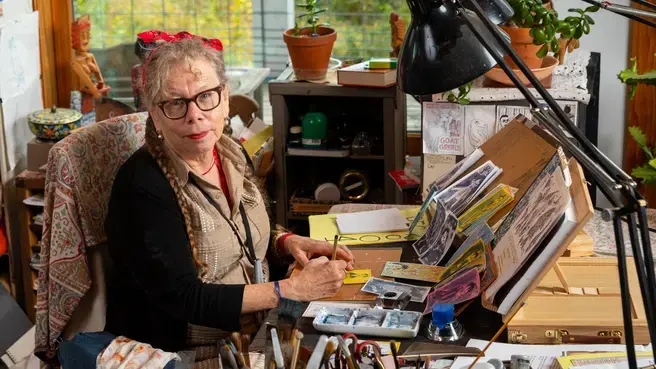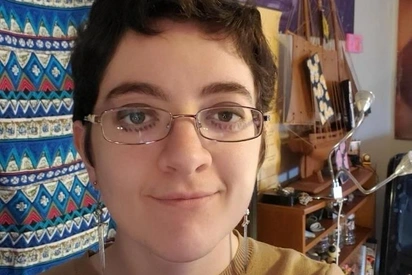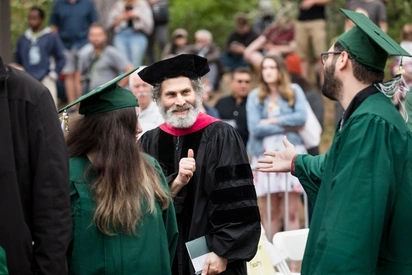
Lynda Barry ’79 sprang fully formed onto the alternate weekly scene, becoming a recurring guest on David Letterman and channeling her idiosyncratic voice into her comics, novels, a play and teaching.
Lynda Barry certainly believes that comics deserve to be taken seriously—“They are able to transfer images from one mind to the next as wonderfully as any other art form.” She laments “the creep of the scholarly approach to comics…Something mighty is ruined when someone tells you exactly how to experience any kind of art in the same way fresh string beans are ruined by boiling the living hell out them.”
If you were to draw a genealogy of Barry’s bibliography—her breakthrough strip “Ernie Pook’s Comeek” (created in 1978), her novel (and later play) The Good Times Are Killing Me (1988), and the writing and art tutorials What It Is (2008) and Picture This: The Near-Sighted Monkey Book (2010)— you can trace it all back to Evergreen, and her mentor, Marilyn Frasca.
“She was mysterious,” Barry writes from the University of Wisconsin-Madison, where she’s spring artist in residence (her first semester-long residency after years of doing five-day workshops around the country). “She seemed very interested in finding out what interested her students and working from there, but somehow she did this with very little conversation. No chatting or small talk. Her information came directly from the work we were doing and she seemed to establish a relationship with our work and then introduce us to it.”
Frasca, who still teaches the occasional class as an emerita professor, joined the Evergreen faculty in 1973, a year before Barry chose Evergreen with the aid of “a really smart English teacher at my high school.” Barry studied the History of the Renaissance and Middle Ages her first year, and the History of Science her second year. “Then my third and fourth year I worked with Marilyn Frasca in one way or another,” she recalls.
“To this day, it’s one of the most powerful things I was given at Evergreen; the idea that the thing I call my work is from a different part of me than what comes off the top of my head,” Barry adds. “To start developing a relationship with that working part of me, the part of me that ‘speaks’ the image language, and to be doing this at the age of 20 gave me a tremendous advantage.”
At the time, Matt Groening was editor of the Cooper Point Journal, where he pledged to print anything anyone submitted. “That was a challenge I wanted to beat him at,” Barry recalls. “I kept submitting crazier and crazier things—outraged letters to the editor about things that happened to me when I was little that had nothing to do with Evergreen, or comics that were really strange, comics about little girls who could do things like remove their arms and legs at will. No matter what I submitted, he printed it. I came to really love him for this and for all of the wild things he was doing with the paper.”
Last fall, Drawn & Quarterly published Blabber Blabber Blabber: Volume 1 of Everything, which guaranteed that Ernie Pook’s Comeek and the works that followed will find an audience for generations to follow. “The alternative weekly jobs may be gone, but there are more cartoonists doing more interesting things than ever before,” says Barry, who has called Footville, Wis., home for the last decade. “All sorts of people are making comics now and, more importantly, all sorts of people are reading them. They’ve become much more like music. In the same way you can make a song about anything, about sad things or horrible things or hilarious things, comics can be about anything. They’re another way to transfer this thing that Marilyn called an image.”



